Partial knee replacements are rapidly becoming a common choice for orthopedic surgeons seeking to offer patients the option of pain relief in the ASC setting. With patient expectations increasing, the MOTO™ Partial Knee System has been designed to simplify the challenges of gap balancing and alignment — truly taking the potential of a partial knee procedure to the next level.
This content is sponsored by Medacta.
J. Mandume Kerina, MD, of Leesburg (Fla.) Regional Medical Center, has performed hundreds of mobile and fixed bearing partial knees, taught countless surgeons in both techniques as a surgeon educator and lately has led a team of experts in detailing the road map for the next generation of UKA, the MOTO Partial Knee System. Both mobile and fixed bearing implants have been highly successful, yet each has room for improvement.1 The team’s mission was simple: make today’s unicompartmental knee arthroplasty that serves all patients, from elderly to high-demand, in all sizes ranging from the petite to the professional athlete, and is well suited for today’s ASCs with efficient trays and no requirement for expensive robotic technologies.
So, why MOTO? Aside from implant design, instruments and education are key components.
The design rationale required a compartment-specific approach. The MOTO implants are designed for each specific compartment using an anthropometric database of thousands of knee CT scans to optimize anatomic coverage, contours, size range and precise fit. MOTO is a cemented fixedbearing UKA, using proven materials.
The Co-Cr-Mo femoral component comes in 10 sizes; the titanium alloy (Ti-Al6-V4) tibial tray comes in eight sizes, and the high-quality polyethylene insert in single-millimeter incremental thicknesses. It is a round-on-flat design that minimizes shear stress on the implants, and allows for all femoraltibial size combinations. The femoral component is anatomic, with anatomic posterior femoral condyle coverage for deep flexion. It has cement interdigitation recesses, and two pegs which diverge from the posterior flange for secure fixation (three pegs on largest sizes). Likewise, the tibial tray has the cement interdigitation recesses, two pegs and a keel.
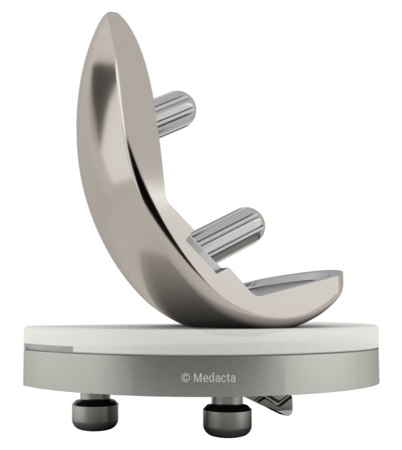
Perhaps the most distinguishing feature of MOTO is the instrumentation that allows for precise bone resections to balance knee flexion-extension gap mismatch, while maintaining slight alignment under-correction. UKA is unique in that the implants must be placed within a given soft tissue envelope specific to that knee, without ligament releases, and still achieve balance and alignment goals. This requires precise (1 mm) bone resections on the tibia, distal femur and posterior femoral condyle. MOTO enables the surgeon to independently adjust flexion and extension gaps, and allows the surgeon to change any step all the way up to cementation. Even the medial-lateral positioning of the femoral component can be changed after trial reduction to optimize positioning. All femoral components have the same two lug holes, distal and posterior cuts, enabling a change in femoral component sizing even after the cuts and lug drill holes were made.
The Medacta commitment to surgeon education is a key component to the success of MOTO. Surgeons benefit from one-on-one instruction and proctoring as well as visiting design surgeons and attending learning centers for didactics and cadaver lab training.
Anthony Robins, MD, of Yarrow Point, Wash. sat down with his fellow MOTO design surgeons to find out how MOTO was already making a difference in their individual practices. Below is an excerpt from these discussions with Dr. Kerina, Akbar Nawab, MD, of Louisville, Ky.-based Ellis & Badenhausen Orthopaedics, and Ryan Molli, DO, of Whole Health Joint Replacement Institute in Meadville, Pa.
Question: Was changing to MOTO a difficult transition?
Dr. Mandume Kerina: No. Transitioning was easy because the principles of partial knee replacement are the foundation for the Moto surgical philosophy, a balanced aligned resection.
Dr. Akbar Nawab: Not for me either. As a joint compartmentalist, I am looking to have the best long-term survivorship for my partial knee replacements and this means not only a durable and reliable arthroplasty but also preserving the contralateral compartment from failure. Alignment accuracy with Moto is beautifully refined with a combination of measured resection and gap balancing.
Dr. Ryan Molli: The transition was easy as the instrumentation is similar to commonly performed knee arthroplasty. The surgical technique is very well thought out and the instrumentation versatility allows precise balancing in both flexion and extension
Q: Did you have to change your patient positioning, draping and exposure?
MK: No, same as I’ve always done. I like the DeMayo Knee Positioner® because I have great control over the leg and find it helps to leave my hands free when teaching surgeon visitors.
AN: I use a leg holder too, no changes. And as an educator for ZUK for years, I agree with Dr. Kerina’s remark.
RM: I was trained on and used the Oxford® for years, and prefer thehanging leg technique, and have had no need to do anything different.
Q: How are you using it in your practice?
RM: I have a high-volume joint replacement practice. MOTO is very efficient in the hospital setting, and my staff loves the simplicity of only three trays.
Q: What features make this UKA the best for your sports medicine/ outpatient practice?
AN: As a knee surgeon who specializes in joint preservation as well as reconstruction, I tend to treat younger patients, and have transitioned most of my patients into my ASC, where this procedure is performed as an outpatient arthroplasty. It is efficient, and addresses any issues I might encounter, even in the ACL-deficient or reconstructed patients.
Q: What excites you most about this new system in your hands?
RM: I now feel like I’m in complete control of every step of the UKA, and perhaps most importantly, I now have a mechanism to minimize the tibial resection thickness by adjusting my posterior femoral condyle resection level.
AN: I love the ability to decide, on every patient, exactly how I want to balance the flexion and extension gaps. And with my younger patients, I know that any future needs, such as a need for a lateral UKA or patellofemoral joint, that all the components were designed to be compatible.
MK: It is nice to have a system in my hands where I can redo or revise any step at any point in the procedure. I am able to make adjustments in very short time and without sacrificing quality.
Q: How has your facility adapted to the change to MOTO?
AN: My ASC loved it! With only three trays, setup is a breeze, and my techs quickly adapted to the new instruments.
Q: Tell us about a case that MOTO provided a solution, that wasn’t possible until now?
RM: I had a recent case when, after osteophyte debridement, my extension gap was 5 mm greater than my flexion gap! I was able to solve this by using the smaller distal femur resection guide and cutting 2 mm more from the posterior femoral condyle with Moto’s unique pre-cutting guides, which placed the femoral component more distal. It led to perfect balance throughout the range of motion, with no further tibial resection. That is the beauty of the MOTO system, independent extension and flexion balancing, which is unlike any other system.
Q: Despite a good preoperative exam, and stress films, are you ever surprised by the flexionextension imbalance? Was MOTO able to address that?
MK: Definitely. I believe in good alignment films as well as a valgus stress film to show me the potential correction. Even still, a large medial osteophyte tenting the MCL can mislead your assessment of laxity. Once removed, it is easy to check the laxity and alignment that drives your resection plan to balance the flexion and extension gaps, while not overcorrecting the alignment into valgus.
Q: Why would an ASC choose MOTO?
AN: As an ASC owner, I’m interested in outcomes, costs, and because it is a business, profitability. MOTO is cost-effective, doesn’t take up a lot of storage space, and allows for very efficient turnover times, and most importantly good outcomes with very low complication rates.
Q: Do you feel a robot would give you an advantage?
RM: No. I’ve done a high volume of arthroplasty, and am quite happy with my outcomes. I don’t deny that a robot might be more accurate, but this has not been shown to yield better outcomes. The soft tissues tell me how much alignment correction I can gain. Knowing my alignment goals I believe I can better balance gaps with the MOTO instruments.
AN: As an owner of an ASC, I am simply not interested in the capital expenditure of a robotic system, the longer turnover times, and from a practical point of view, storing it. We have very limited storage space. This procedure, in many respects, is a soft tissue procedure with bone resurfacing. We all aim for knees that are stable and correctly aligned, which requires accurate assessment of the soft tissue balance. I am not sure that a robot can make this dynamic assessment. While a robot may help with bone resections I don’t trust it to balance a knee.
Q: How has Medacta supported education for MOTO?
RM: Every surgeon gets the full support of the Medacta education “machine.” There is one-on-one instruction, ability to visit surgeon reference centers to see several cases in one day, learning centers with didactics and cadaver labs and of course the presence of a proctor in the first cases. It doesn’t stop there. Frequent tips and tricks, case presentations and education reminders are delivered via email periodically. These features continue with time.
Q: The Oxford mobile bearing UKA was designed to minimize wear.1 Do you see wear as a major cause of failure with UKA?
MK: Interestingly, no. Aseptic loosing, infection and advancing OA into other compartments of the knee are the most common failure modes. We took great care with Medacta engineers to design MOTO components to optimize fixation and thus prevent aseptic loosening. I’m very respectful of the mobile bearing outcomes, yet we wanted a solution that applied to every knee.
Q: Did you feel apprehension going into a case prior to MOTO?
RM: I did have some apprehension with the Oxford, because it’s difficult to change once you’ve started down the pathway. I take comfort in knowing that
I can change gaps, implant size and positioning if I need to.
AN: I did have apprehension with the ZUK in dealing with knees with significant flexion-extension gap mismatch. I was forced to do some interesting free-hand adjustments or resect more tibial bone, but now I know I have all the instruments needed to address any situation with this system.
Q: The accurate implant sizing allows for full cortical rim contact on the tibial component to prevent subsidence. The femoral component has an extended posterior condyle to allow patients deep flexion without posterior impingement. What other features do you feel are important for you with the MOTO Partial Knee System?
AN: The ability to make resections to the millimeter with independent flexion and extension balancing has been the greatest feature for me. I never have to worry about overcorrecting a knee. This allows me to obtain the perfect alignment and a well-balanced knee.
RM: The fact that I have never burned any bridges with this technique [is an important factor]. By that I mean that I can revise any step through the surgery. If I want to go back and fine tune one of my first steps I can do that as easily as I can the step I just finished. I can even change the femoral component up or down a size after the lug holes have been drilled. It is the most flexible system I have ever used.
MK: The goals to reduce failures have been well addressed with this system. I appreciate the safety features like cutting the distal femur in flexion and minimal pin fixation needed for the tibial cut guide. It is the most versatile and reliable system I have ever used. What my colleagues have said is very true and this all can be summarized in the surgical philosophy of the Moto system — balanced aligned resection.
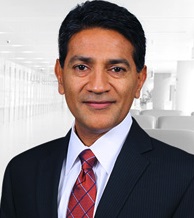
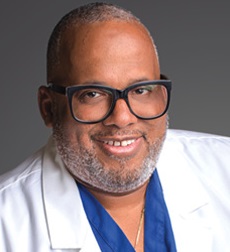
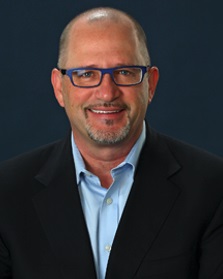
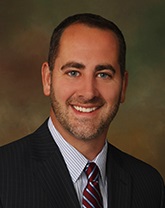
Pictured left to right: Dr. Akbar Nawab, Dr. J. Mandume Kerina, Dr. Anthony Robins and Dr. Ryan Molli
References
1Murray DW, Goodfellow JW, O’Connor JJ. The Oxford medial unicompartmental arthroplasty: a ten-year survival study. The Journal of Bone and Joint Surgery, British Volume. 1998 Nov.;80(6):983-9.